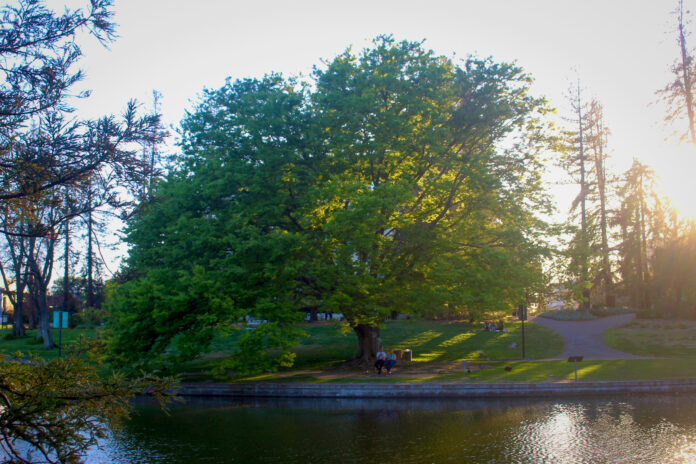The Texas Tree Trials, a research project created by the Urban Tree Stewardship, seeks to create a campus environment that is better suited to Davis’s changing climate
By LILY FREEMAN — campus@theaggie.org
With hotter summers and wetter winters on the horizon, the UC Davis Arboretum and Public Garden is working toward adapting all trees on campus to Davis’s weather conditions. The Texas Tree Trials, a research project created by the Urban Tree Stewardship internship program, is an effort to improve the resilience of the UC Davis tree canopy, according to its website.
Nurjannah Wiryadimejo, a fourth-year environmental science and management major and co-coordinator of the internship, provided more detail about the project.
“Our trees on campus are not currently prepared for the climate that is oncoming, as many can see — with the recent storm event, a lot of the trees fell down on campus,” Wiryadimejo said. “Keeping that in mind, we came up with this idea of going to Texas and getting seeds of certain trees that match the changing climate in Davis. Our team brought those trees back here, germinated them in our nursery and planted these trees all around campus, which has become our living lab.”
According to Wiryadimejo, Texas was the best place to collect seeds because the state shares a similarly expected future climate of Davis and is home to a wide range of trees that are well equipped to handle droughts, storms and certain soil types.
Sam Vitt, a fourth-year environmental science and management major and the other co-coordinator of the internship, outlined the timeline of the project. The collection of tree samples took place in 2019 and since then, the group has been planting trees across campus and monitoring them each spring.
“We [want to] see what we can take away from these trees, asking whether or not they can survive on our campus in our future urban tree canopy,” Vitt said.
There are several plots located around campus, but the main research grove is near the Mondavi Center.
Wiryadimejo explained the difference between the trees that have previously grown across campus and the ones that have been planted as part of the project.
“Redwoods are very prevalent on our campus,” Wiryadimejo said. “If you look at our redwoods, they do not appear very healthy. If we’re being realistic, redwoods need so much water and they thrive on fog and constant irrigation, and that doesn’t work with our climate. With that, we’re leaning towards cypress [trees] that give off the feel of redwoods but are more drought tolerant and can handle acidic soils.”
Vitt described the process of planting these cypress trees, noting that they recently planted a group of Arizona cypress trees between the stumps of redwoods that were recently cut down near Meyer Hall.
“Now, there are all of these little baby trees that will hopefully one day cover up the ugly parking lot where the redwoods once stood,” Vitt said.
To allow the community to learn more about the trees, according to Vitt, the internship program created a database that describes each tree, its potential on campus, why it is important for urban forestry and why it was chosen for the Texas Tree Trials.
The Texas Tree Trials project is funded by both the Arboretum and Public Garden and The Green Initiative Fund (TGIF), according to Wiryadimejo. She said that a vast amount of the funding that has allowed them to transform the campus tree landscape has come from TGIF, which will appear on the ballot in the 2023 spring ASUCD elections in the form of a fee referendum that would provide continued funding for the project.
The Urban Tree Stewardship, through the Texas Tree Trials, has planted over 250 trees this school year with the help of the internship team and several volunteer tree-planting events.
Mara Feldman, a second-year environmental science major, described her experience as a volunteer for Urban Tree Stewardship.
“It was a super rewarding experience since the trees we were planting were picked for their drought-resistant qualities,” Feldman said. “This is super important in the changing climate we’re experiencing. As an environmental science major, I know how critical it’s going to be in the coming years to adapt to climate change and do our best to help out where we can.”
The project is ongoing, according to Wiryadimejo, and the Urban Tree Stewardship program plans to continue to monitor the growth of these trees until their full maturation, which could take anywhere from 20 to 50 years.
“Our internship applications open up over the summer for the next school year and we will announce [them] on the Arboretum website and Instagram page,” Wiryadimejo said. “We also have a ton of community tree-planting events coming where you can volunteer to plant trees, typically during fall and winter quarter.”
Vitt concluded by saying that her experience with the project so far has been “so rewarding,” both personally and through seeing volunteers and interns enjoy themselves and their work.
“I just really enjoy that we get to see these trees that we planted and the impact that they are making […] both on students and for our changing campus climate,” Vitt said.
Wiryadimejo also described the joy she has in watching others get excited about the project.
“It is so cool to be able to teach people something new,” Wiryadimejo said. “I love seeing the glitter in people’s eyes when they plant their first tree.”
Written by: Lily Freeman — campus@theaggie.org




